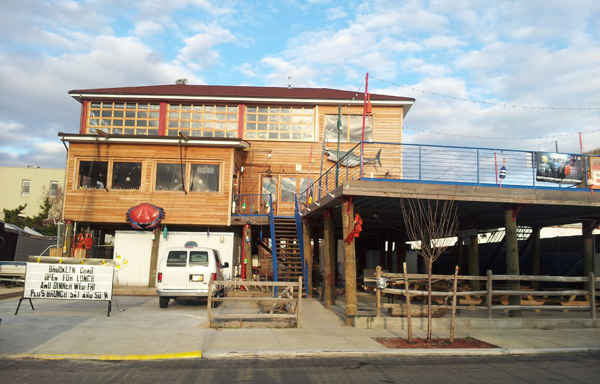
Photo by: Batya Ungar-Sargon
Brooklyn Crab is open for lunch and dinner. But other Red Hook businesses are struggling to recover from the hit Sandy dealt.
Red Hook has changed significantly in the last fifteen years. “Sixty or so small companies turned this neighborhood around,” Dan Breston says, owner of multiple buildings as well as the chocolate and liqueur distillery Widow Jane Spirits.
But many of these small businesses have sustained devastating damage due to Hurricane Sandy.
Van Brunt Street, home to many of those firms, was entirely submerged under water. One company that furnishes airlines with supplies estimates the damage at $100,000. Another Van Brunt business that wished to remain anonymous estimates the damage at $1 million. Jerimedix, a business that sells medical supplies on Van Brunt, also sustained significant damage.
“There was five feet of water here and no warning,” manager Israel Pearlstein says. Despite the work ahead, there was a jovial atmosphere in the warehouse. “We’re struggling, but we’re surviving. We’ll be fine,” Pearlstein says.
When asked about FEMA, all business owners said the same thing. “You can apply for a loan, but it’s not much,” one owner said. “You’re just a number,” said another. Business owners expect to cover the losses themselves. “FEMA’s a joke,” Breston says. “Only 5 percent of the aid was offered to businesses.”
Mayor Bloomberg has recently announced a $5.5 million matching grant for small businesses. The Brooklyn Community Foundation has also awarded $100,000 to the Red Hook Coalition for recovery efforts to the Red Hook Coalition made up of Good Shepheard Services, Added Value, Red Hook Initiative and others to be allocated to small businesses as micro-grants, as well as for the immediate relief of residents.
Jim Tempakis is the owner of a few businesses and properties in Red Hook. He has been in the neighborhood since 1974, when he started his shipping repair business. All five of his properties, totaling over 100 square feet, were submerged in 4 to 5 feet of water. He estimates the damage at half a million dollars, including the loss of machinery and forklifts. “It’s challenging,” he admits when discussing the available aid from FEMA. He too thinks he will have to cover the damage himself, but he says that others have decided to leave the area. “It’s an M1 Industrial Zone,” he says. “We have heavy equipment and we have to be on the first floor, which makes us vulnerable to flooding.” This is why flooding insurance is unavailable for areas like Red Hook. One person called it “Zone A+.”
Other Red Hook staples like Fairway remained closed, though they have confirmed that they are protected by Business Interruption Insurance, which pay wages as though the business were open, as well as Property and Damage Insurance, though they are still waiting to see if the latter covers flooding.
Public housing struggles
But this business community, many of who also live in Red Hook, represents only a portion of the Red Hook’s community. The other half live in the second largest public housing facility in New York City. The public housing buildings, of which there are 32, only had their electricity restored this past Sunday, according to residents. Some apartments are still without electricity, residents report.
(NYCHA spokeswoman Sheila Stainback told Brooklyn Bureau: “We have no outages at any of the buildings in the Red Hook Houses. However, because the buildings are on temporary systems (generators/boilers), the service can be intermittent, as we have shared with residents in a newsletter keeping them in the loop on recovery efforts. ” She advises residents having service problems to call 718-707-7771. “NYCHA is keeping a close eye on all outages, particularly where buildings are on temporary systems,” she adds.)
“This is no different than Katrina,” a middle aged resident named Chico said. “These are low-income folks, and minorities. And that’s a damn shame, because there’s lots of kids in here. If this was the Upper West Side, they’d have been working a lot harder.”
The New York City Housing Authority recently received a $7.1 million grant from the U.S. Department of Labor to hire laborers for post-Sandy recovery jobs. Many of these jobs in Red Hook seem to have gone to Belfor Property Restoration who were hard at work on Tuesday draining basements of debris and dehumidifying.
Nonprofits bridge the gap
Nonprofits in Red Hook have been actively assisting recovery efforts in both the business community and the public housing community. In perhaps one of the few efforts to bridge the gap between these two communities, the Red Hook Initiative, which focuses on community and youth development, has worked on connecting the Van Brunt businesses with volunteers, Frances Medina, a consultant for the Initiative, reports. “Because we are a non-profit, we cannot give grants to businesses, but we can help with rebuilding efforts,” Medina explains. But they also raised money through donations for small businesses.
Red Hook Initiative’s mission is to empower, employ and educate the youth of Red Hook’s public housing. Their post-Sandy efforts have included immediate relief for housing residents, such as supplies, legal and medical services, and homebound meals, as well as employing individuals who live in public housing in Sandy-related jobs. They partnered with FEMA to get work for unemployed Red Hook residents as social workers and mental health care workers. The FEMA trailers were themselves staffed by residents and Red Hook Initiative staff.








